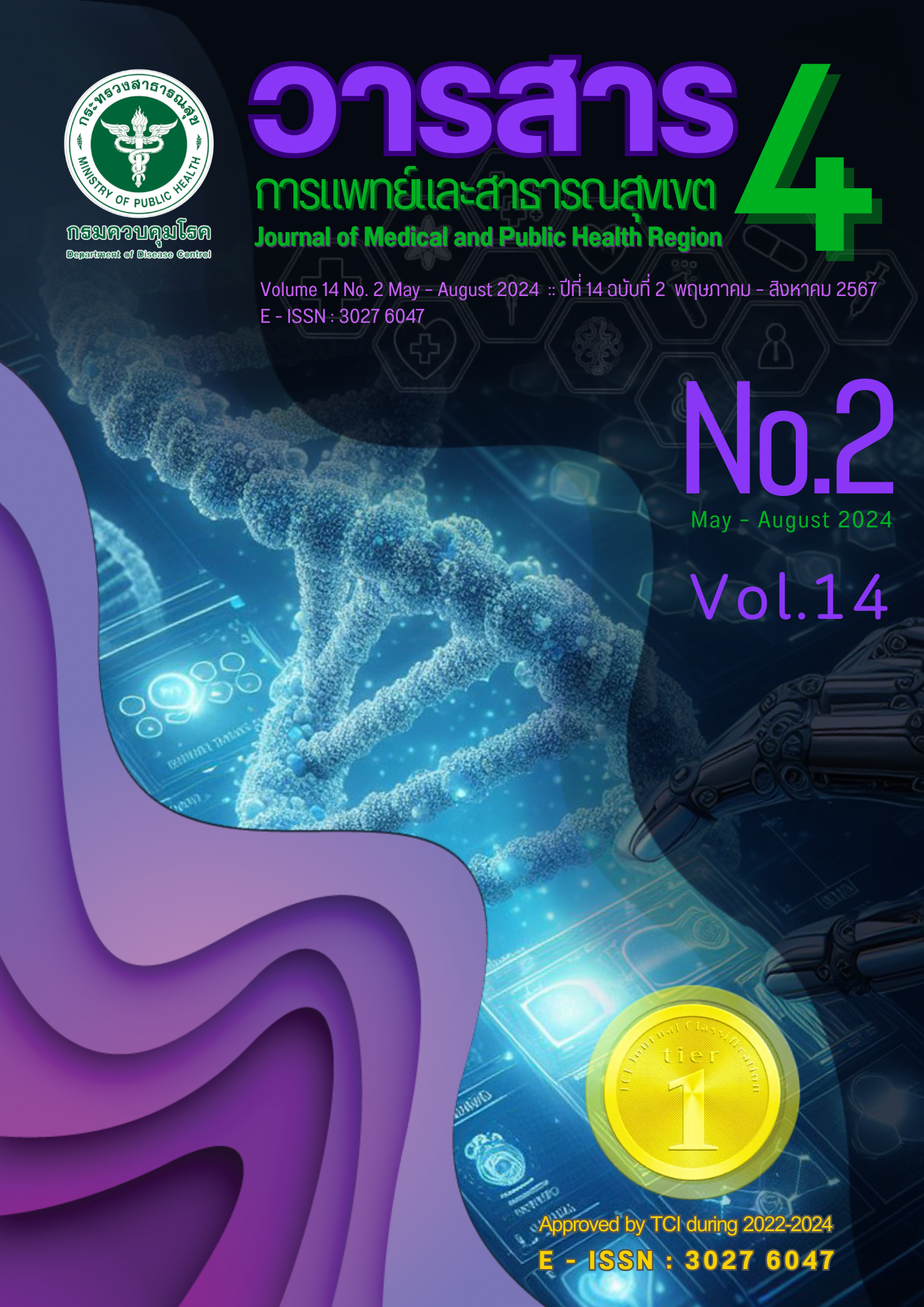The causal relationship model of factors influencing fall prevention behaviors of the elderly in Lopburi Province
Main Article Content
Abstract
The purposes of this quantitative research were to study the level of fall prevention behaviors of the elderly,
to develop a causal relationship structural equation model of factors influencing the fall prevention behaviors of the elderly, and to examine the pathways of influence of causal factors on fall prevention behaviors. The sample consisted of 520 elderly people living in Lopburi Province and were selected by multi-stage sampling method. Data were collected using a 5-rating scale questionnaire with a content validity index between 0.60 - 1.00 and questionnaire reliability index of 0.92. The statistics used for data analysis were percentage, mean, standard deviation, influence path analysis by using a computer program.
The results showed that the developed model was consistent with the empirical data (Chi-square = 259.96, df = 133, c2/df = 1.95, Index GFI = 0.91, AGFI = 0.86, RMSEA = 0.042). The direct coefficients of self-efficacy and attitude towards fall prevention in elderly fall prevention behavior were 0.86 and 0.44, respectively and the fall prevention behaviors of the elderly were indirectly influenced by health belief model and social support through self-efficacy and attitude towards fall prevention with the influence coefficients of 0.84 and 0.24, respectively. All variables could explain 65% of the variance in fall prevention behavioral variables. In summary, fall prevention among the elderly should promote self-efficacy awareness and have a positive attitude to prevent falls.
Article Details

This work is licensed under a Creative Commons Attribution-NonCommercial-NoDerivatives 4.0 International License.
References
Foundation of Thai Gerontology Research and Development Institute (TGRI) SITUATION OF THE THAI ELDERY 2021 Bangkok: Amarin Corporations Public Company Limited. 2022.
World Health Organization. Fact Sheet: Falls. [Internet]. 2021 [Cited 2022 Mar 15]. Available from: https://www.who.int/news –room/fact –sheets/detail/falls.
Mishra N, Mishra AK, Bidija M. A study on correlation between depression, fear of fall and quality of life in elderly individuals. Int J Res Med Sci [Internet]. 2017 [cited 2022 Mar 25]; 5(4): 1456 –60. Available from: https://www.msjonline.org/index.php/ ijrms/article/view/3088
Ministry of Public Health, Department of Disease Control. 2023 [FP] Data on the number and rate of out –patients (OPD) caused by falls (W00 – W19) in the elderly aged 60 years and over, 2017 – 2022. [Internet]; 2023 [Cited 2023 Aug 15]. Available from: https://ddc.moph.go.th/dip/news.php?news=34701&deptcode=
Sarapun A, Sirisopon N, Kainaka P, Onsiri S, Outayanik B, Threrawachjareanchai S, et al. Factors ralated to a fall prevention behavior of elderly. Journal of The Royal Thai Army Nurses 2017; 18: 215 – 22. (in Thai)
boonkrabpong S, Junrith K, Thanawat T. Factors influencing fall prevention behaviors in elderly people, Tha It Sub – district, Mueang district, Uttaradit province. Academic Journal of Community Public Health 2022; 8(4): 45 –55. (in Thai)
Chaisang U, Chaisang N, Cheha Nand Arleedeeman N. Guidelines for Fall Prevention among Older Persons: A Study on Correlations Between Perceived Self –Efficacy and Fall Prevention Behaviors in Yala Province. The Southern College Network Journal of Nursing and Public Health. 2021; 8(1): 293 – 307. (in Thai)
Tasuwanin T,Tappakit K. Effects of Falling Prevention Program for Elderly. Journal of Nursing and Health care 2017; 35(3): 186 – 95. (in Thai)
Judy A, Stevens P. A CDC compendium of effective fall interventions: What works for community –dwelling older adults 2nd ed. National Center for Injury Prevention and Control of the Centers for Disease Control and Prevention. 2010.
Hair, J.F., Black, W.C., Babin, B.J, Anderson, R.E. Multivariate Data Analysis. 7th ed. New York: Pearson; 2010.
Hair, J.F., Risher, J.J., Sarstedt, M. and Ringle, C.M. When to Use and How to Report the Results of PLS – SEM. European Business Review 2019; 31: 2 – 24. Available from: https://doi.org/10.1108/EBR – 11 – 2018 – 0203.
Diamantopoulos, A., Siguaw, J. A., Introduction to LISREL: A guide for the uninitiated. London: SAGE Publications; 2000.
Schermelleh – Engel, K., Moosbrugger, H., and Müller, H. Evaluating the fit of structural equation models: tests of significance and descriptive goodness – of – fit measures. Methods Psychol. Res. Online 8: 23 – 74. 2003.
Goffin, R. D. Assessing the adequacy of structural equation model: Golden rules and editorial policy. Personality and Individual Differences 2007; 42(5): 831 – 9.
Poungthong N, Keeratisiroj O. Factors influencing falls prevention behavior among the elderly in Thapthan district, Uthaithani province. Journal of Health and Nursing Research 2022; 38(1): 73 – 85. (in Thai)
Akkhanan T, Srimarksuk K, Wongsrisung T, Siripaiboon C, Duangchinda A, Pilaporn S. Factors associated with behaviors of falls prevention among Thai elderly in the community at Doem Bang Nang Buat, Suphan Buri Province. KKU Journal for Public Health Research 2021; 14(4): 72 – 89. (in Thai)
Rodsungnoen J. Effects of Exercise Programs on Balance and Fear of Falling among Elderly in the Community. Regional Health Promotion Center 9 2021; 15(38): 541 – 60. (in Thai).
Bandura. A. Social Foundations of Thought and Action: A Social Cognitive Theory. Englewood Cliffs: NJ: Prentice Hall; 1986.
Ounlamai S. A Study of the Relationships between Personal factors Perceived Benefits Barriers and Self – efficacy in Fall Prevention and Fall Prevention Behaviors among the Elderly living in Community. [Internet][Master of Nursing Science Thesis in Gerontological Nursing, Graduate School, Khon Kaen University: 2010 [cited 2022 Jan 15]. Available from: https://dric.nrct.go.th/Search/ShowFulltext/2/257268. (in Thai)
Rokeach,Milton. Beliefs,Attitudes and values.San Francisco:Josey Bass; 1970.
Suwan P. Measuring Health Status: Creating an Estimate Scale and a Questionnaire.Bangkok: Printmaking Publishing House; 1994.
House, J. S. Work stress and social support. Reading, MA: Addison –Wesley; 1981.


